
Sligo Creek Golf Course Stream Restoration Project
Tour Led by Doug Redmond and Andy Frank of M-NCPPC
April 2, 2007
An aerial view of the stream running south into the stormwater pond
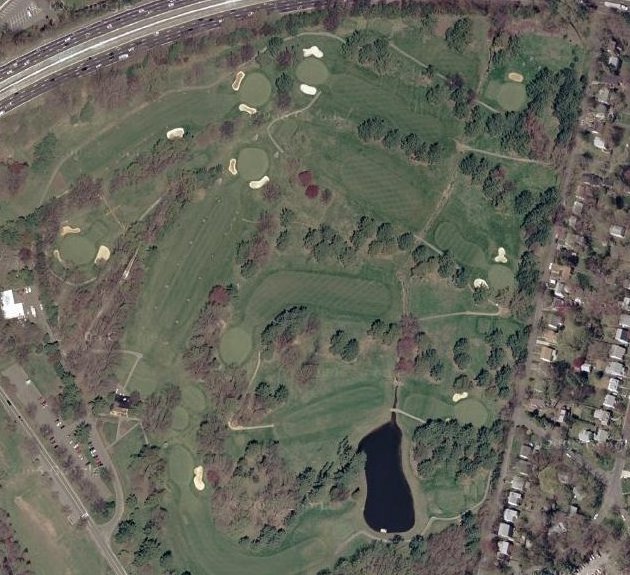

To address the stream damage, M-NCPPC has been implementing a $300,000 stream restoration project on the Sligo Creek Golf Course. The steam restoration project includes dredging 100 cubic yards of sediment from the stormwater pond, creating a shelf along the stream that acts as a floodplain, stabilizing the stream bed erosion, replacing round culverts, adding new or protecting existing meanders, adding cobbles (big stones) in the stream, and incorporating native plantings along the stream.
The restoration work starts at the in-line stormwater pond at the Sligo Creek Golf Course. 100 cubic yards of sediment were removed. The restoration plans call for the installation of native vegetation around the pond.
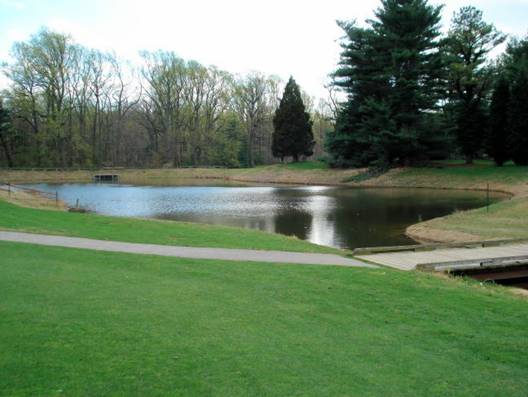

Double Log Drop - This practice creates a two step structure that stabilizes the stream bed. Along the stream at some of the meanders, these Double Log Drops were installed. They are intended to reduce erosion caused by "head-cutting". "Head-cutting" occurs when there is a sudden drop in elevation in the stream, causing the water to stir up the stream bed and erode sediment which heads down stream.
The Double Log Drop structures were selected in part also because they do not form a fish blockage.
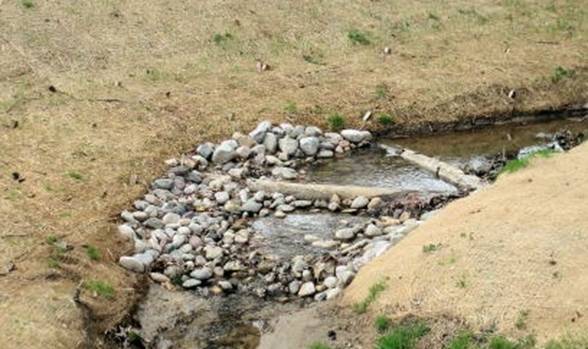
The Double Log Drop structures were selected in part also because they do not form a fish blockage.

Portions of the steep stream bank were removed. Stream banks near trees were left undisturbed. The shelf structure along the stream allows the stream to spread out over a wide area, reducing the stream velocity and dissipating the energy in the flowing stream when it rains. This reduces the erosion in the stream bed. The construction office is working with M-NCPPC's Forest Ecologist (Carole Bergmann) and the M-NCPPC Horticulturalist (Holly Thomas) to plant native plants such as purple cone flower and Rudbekia, creating a vegetated stream buffer instead of lawn along portions of the stream that are not "in play" in the golf course.
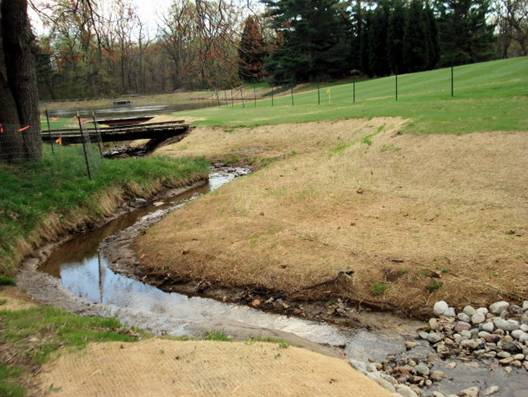

The old round bottom culverts, which were fish blockages, were replaced with
wider more natural oversized culverts with a natural bottom.
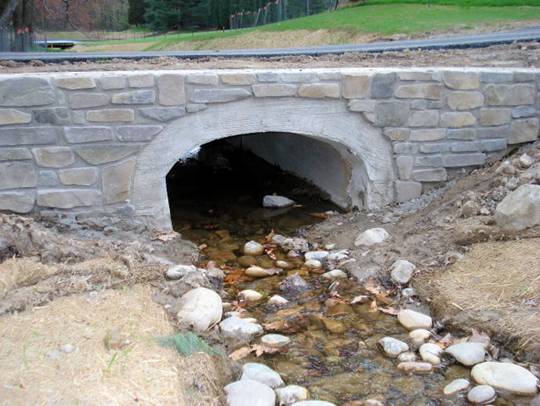
wider more natural oversized culverts with a natural bottom.

Along the stream series of a cobble riffles (places where the water can bubble over stones or other matter) were installed. Riffles are important aquatic habitat in this region.
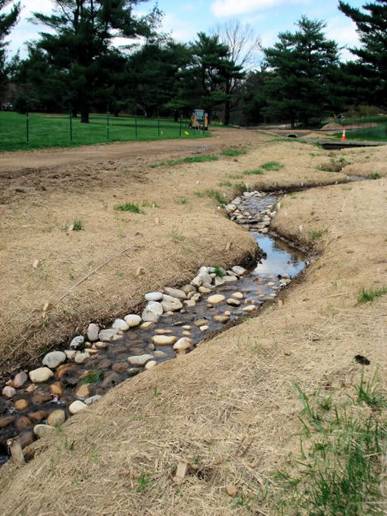

In addition, the golf course staff uses nutrient load management practices - that is, they manage the amount of fertilizer and pesticide they use so as not to cause undue disturbance to the stream. They are working with M-NCPPC to maintain the new vegetated buffer area.
Many thanks to Andy Frank and Doug Redmond (both from M-NCPPC) for providing the tour of the Sligo Golf Course Restoration Site.
According to Mr. Redmond, the project is intended to improve physical habitat conditions. This is a vast improvement, taking a lot of time and effort, but this work only addresses the symptoms of uncontrolled runoff from impervious surfaces throughout the drainage area of this stream. Until the source of the runoff problems is addressed, there will be little improvement in the biological water quality of the stream. This means the stream will not be able to support normal fish and other life. To see what it would take to improve the biological health of the stream, I visited the source of the stream on April 8.
You need to go across the Capital Beltway to the South Four Corners Park to see the source of the Sligo Creek Golf Course stream and why it will be difficult (though not impossible) to restore the biological health of the stream. Since this is typical in the Sligo watershed, this is also relevant to Sligo Creek.
The Source of the Sligo Golf Course Stream at South Four Corners Park
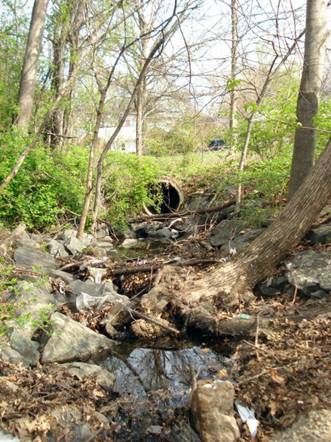

The source of the steam can be found in a trash strewn and invasives covered corner in the South Four Corners Park. There you will find an abandoned trash-strewn stormwater basin and two stormwater mains that are the source of the stream.
Abandoned stormwater basin at South Four Corners Park. Concrete stormwater riser in the background.
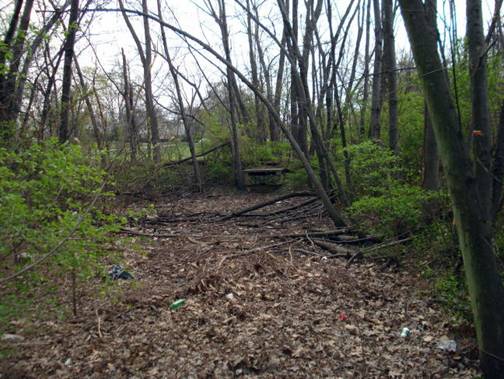

With so much hard surface (including portions of Forest Glen Road) covering the headwaters of this stream, there was little baseflow (dry weather flow) during my visit even though it is early spring. I moved thorn bushes and use a flash light to look into one of the stormwater mains to find the stream's life-sustaining dry weather flow. The dry weather stream flow never makes it out to the stormwater outlet. Instead it disappears into a gap in the old stormwater main and reappears under the stormwater outlet. This discovery did not surprise me. Meanwhile the runoff from the adjacent large parking lot for a Senior Center flowed into the abandoned stormwater basin.
Stormwater Outlet near the Source of the stream


The source of the Sligo Creek Golf Course Stream
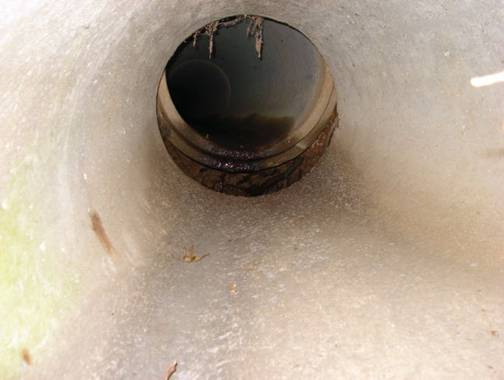

To restore the stream's biological health, the County and residents throughout the watershed will have to begin keeping rainwater on their properties so that it can filter into the ground. The senior center parking lot, as well as other parking lots in the area, could be landscaped so that stormwater running off the lots would be cleaner than the water now going into the stream. The County's Department of Environmental Protection could repair and retrofit the abandoned stormwater basin so it would improve water quality. The entire basin could be cleaned up and turned into a bio-retention system - a place to slow down water flow so that at least some of it filters into the ground. Homeowners in the watershed need to be encouraged to install rain gardens and other Rainscapes practices. In short, restoring the streams health will require inter-agency coordination and homeowner participation.
Ed Murtagh
April 2007